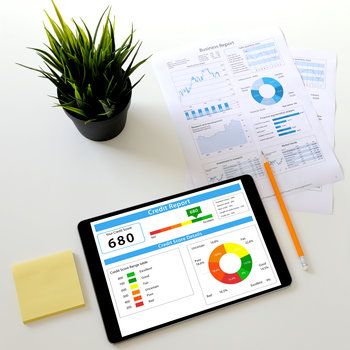 In the U.S. two companies dominate the credit scoring industry: FICO® and VantageScore®. What is a FICO score? What is a VantageScore? Both companies develop credit scores that lenders and creditors can use to evaluate applicants and manage customers' accounts. However, there are differences between Vantage and FICO scores.
In the U.S. two companies dominate the credit scoring industry: FICO® and VantageScore®. What is a FICO score? What is a VantageScore? Both companies develop credit scores that lenders and creditors can use to evaluate applicants and manage customers' accounts. However, there are differences between Vantage and FICO scores.
Not only can there be differences in the scoring models from these two companies, there are also a number of older and newer credit scoring model versions that lenders may use in making decisions. These include so-called "base" credit score models and those that are "industry specific", such as those used for credit cards or auto loans, for example. Industry-specific models and version employ different weighting characteristics to produce scores different than a general "base" model would.
See current mortgage rates for all credit tiers
VantageScore vs. FICO credit scores
VantageScore and FICO scores have the same purpose -- to objectively predict how likely a consumer is to default on his or her debt. However, the models weigh the factors that make up the score differently. Here are some of the main differences between VantageScore and FICO scores:
Tri-merge vs individual bureaus
VantageScore created a single model used by all three credit reporting agencies (CRAs): Experian, Equifax and TransUnion.
FICO has three slightly different scoring models -- one for each CRA. Depending on their needs, a lender may use a score produced from one agency or combine two or more. For mortgages, the most common combination has always been the "tri-merge", where all three credit reports are used in making the decision to grant credit. This is changing, since FHFA will allow Fannie Mae and Freddie Mac to start to accept a "bi-merged" report from two CRAs, although the October 2022 announcement noted that Fannie and Freddie "will work with stakeholders on a plan for implementing the change from a tri-merge credit report requirement to a bi-merge credit report requirement," without providing any sense of when this will actually occur.
Both VantageScore and FICO scoring systems come with variations for specific industries, like mortgage, auto financing and insurance.
Minimum requirements to get a credit score
FICO requires an account (aka "trade-line") that's at least six months old. In addition, you must have activity on at least one trade-line during the previous six months (they don't need to be the same trade-lines).
You may be scorable by VantageScore as long as your credit report has at least one account in it, even if the account is less than six months old.
Additionally, neither credit scoring system will score a credit report if the report indicates the consumer is deceased.
If you don't have a credit score, it doesn't mean that you can't get a mortgage. There may be an alternative route to mortgage approval you can use to secure a loan.
Check your credit grade with this credit score calculator
Credit Score Ranges
Both scoring models assign higher values to the most creditworthy consumers. Riskier applicants for credit receive lower credit scores.
The base FICO scores range from 300 to 850, while FICO's industry-specific scores range from 250 to 900.
Older versions of the VantageScore ranged from 501 to 990, but the latest VantageScore 3.0 and 4.0 use the same 300-to-850 range as base FICO scores.
Individual creditors set their minimum scores and score-related rates and terms. But FICO and VantageScore use two different score ranges:
FICO scores:
- Exceptional: 800 and up
- Very good: 740 to 799
- Good: 670 to 739
- Fair: 580 to 669
- Poor: 500 to 579
VantageScores:
- Excellent: 750 and higher
- Good: 700 to 749
- Fair: 650 to 699
- Poor: 550 to 649
- Very poor: 500 to 549
While VantageScore and FICO now use the same 300-850 range, VantageScore tiers run about 50 points lower than FICO tiers.
Related: These 5 Credit Score Errors Can Really Cost You
How FICO and VantageScore weigh different credit score factors
Events on your credit history impact the two scores differently because they place different weight on each factor.
Here is how FICO weighs the factors that comprise its score:
- Payment history: 35%
- Credit utilization: 30%
- Length of credit history: 15%
- Mix of credit: 10%
- New accounts opened: 10%
And here is the VantageScore 4.0 calculation:
- Payment history: 40%
- Age and type of credit: 20%
- Credit utilization: 20%
- Balances: 11%
- Recent credit: 5%
- Available credit: 2%
So if the biggest knock on your credit is high utilization, you may fare better with a VantageScore-using creditor than a FICO score-using creditor. And if you have little credit history, you might not even have a FICO score. But you'll probably have a VantageScore if you have any scorable activity in the last 24 months.
Credit utilization
Your utilization rate can be an important scoring factor because it indicates whether you're managing debt well or spending more than you earn. Carrying card balances above 30% of your credit limits and maxing out credit is an unsustainable pattern that can end in bankruptcy. High utilization is a big red flag, which is why it carries the importance that it does.
FICO Score and most older VantageScore models measure the amount of credit used divided by the amount available. So if the total credit limit for all of your revolving accounts is $10,000, and your balances total $9,000, your utilization is 90%. That's considered very high.
VantageScore 4.0 looks back and considers your utilization trend in its scoring. For instance, it can matter to your score if you typically only make minimum required monthly payments on a credit card payment or if pay your bill in full each month.
FICO's latest model update (FICO 10) also has a version called FICO 10T that also utilizes "trended" data to produce a credit score. Starting in October 2022, both VantageScore 4.0 and FICO 10T are allowed to be used in the underwriting of conforming mortgage loans, those that are sold to Fannie Mae or Freddie Mac. Since allowing these changes means underwriting software across the entire mortgage origination spectrum will need to be updated, the Federal Housing Finance Agency expects that implementation of FICO 10T and VantageScore 4.0 will be a multiyear effort.
The FICO 10 model also treats the use of personal loans differently than in the past. These unsecured installment loans are often used to consolidate and pay off credit card debt, something that can actually improve your credit score. However, if you begin to run up new balances on those recently paid-off credit card accounts, your credit score may fall as a result. As such, it's a good idea to avoid using your credit opportunities in this way.
Collection accounts
Although unpaid collections can lower both the FICO and VantageScore credit score, collection accounts are treated differently depending on whether they are medical or have been repaid.
Initially started with FICO Score 9 and now incorporated into FICO 10, FICO's newest models do not count paid collection accounts against you. It also gives less weight to unpaid medical collections than other unpaid collections. FICO Score 8 doesn't distinguish between medical and non-medical collections and does include paid collection accounts. Both versions ignore collection accounts when the original unpaid balance was less than $100.
VantageScore 3.0 and 4.0 ignore paid collection accounts and give less weight to medical collections, but they both include outstanding collections without regard to amount. Even tiny collections count against you.
Credit inquiries
When you apply for a new account, creditors pull your credit report, and it can hurt your credit scores temporarily. However, scoring models allow you to shop with multiple providers in a short time and only count one credit pull against you.
VantageScore ignores extra pulls that occur within a 14-day window. If you apply for several different loans, even different kinds of loans, within that period, only one pull counts against you.
Recent FICO models have a 45-day shopping window, while older models (including those that are still used for mortgage lending) give you just 14 days to shop for your mortgage. And FICO scores count multiple inquiries against you unless they are for student loan, auto loan or mortgage applications.
Related: Can Paying Rent Help Your Credit Score?
VantageScore and FICO generate multiple credit scores
VantageScore and FICO are both designed to predict a consumer's odds of falling at least 90 days behind on a bill within the next 24 months.
The VantageScore and the base FICO models are used in a wide range of industries. FICO also creates industry-specific auto and bankcard scores, which have slightly different formulas designed to better serve those creditors.
According to FICO, there are six base generations of their scoring models in active use, including FICO 2, 4, 5, 8, 9, 10 -- and a number of industry-specific variants of each. VantageScore is only up to it's fourth generation of its model, and while most lenders are likely to use the newest versions, any of those four might be in use.
How to improve your FICO or VantageScore
You can improve either type of score fairly quickly by paying down large account balances to reduce your utilization. But it takes time to build a good credit history, increase the age of your accounts and develop a track record of on-time payments.
In the newest FICO model, folks that pay off credit card balances each month (called "transactors") are treated more favorably than those who only make minimum payments (called "revolvers"), so one way to improve your FICO score would be to pay off any small-balance credit card accounts as you go, rather than keeping multiple accounts running small balances each month.
Want to instantly increase your credit score? Experian Boost™ helps by giving you credit for the utility and mobile phone bills you're already paying. With older scoring models, those payments could not help your score -- only harm it if an account went into collection.
In addition, your mortgage lender can help you correct errors on your credit report. Mortgage lenders have access to a service called "rapid rescoring" that may help increase your score in one to two days when you apply for a mortgage.
This article was updated by Keith Gumbinger.
See and compare today's mortgage rates



